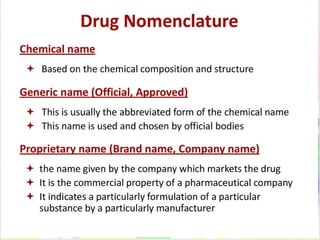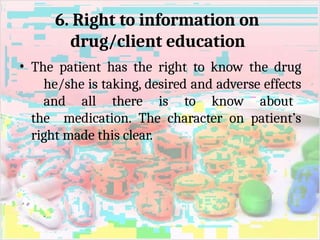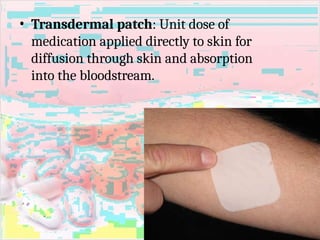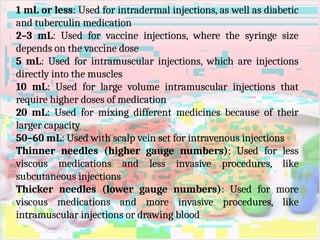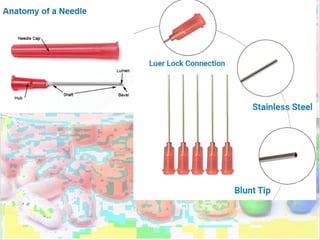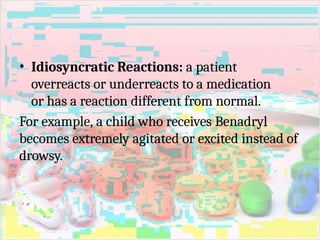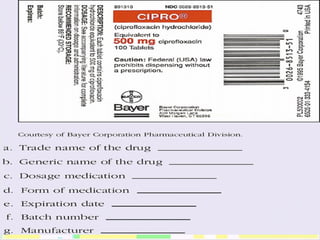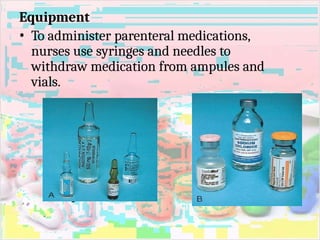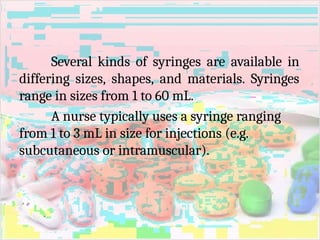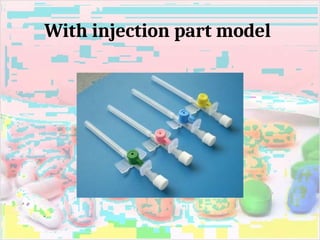Administration of medication.Medication administration: the direct application of a prescribed medication—whether by injection, inhalation, ingestion, or other means—to the body of the individual by an individual legally authorized to do so.
- 5. • Pharmacology is the study of the effect of drugs on living organisms. • A medication is a substance administered for the diagnosis, cure, treatment, or relief of a symptom or for prevention of disease.
- 6. • The written direction for the preparation and administration of a drug is called a prescription.
- 7. Purpose of medication these any Drugs can be administered for purposes: • Diagnostic purpose: to identify disease • Prophylaxis: to prevent the of disease. heparin to prevent thrombosis occurrence eg:- or antibiotics to prevent infection. • Therapeutic purpose : to cure the disease.
- 8. Uses of Drugs ⚫Prevention- used as prophylaxis to prevent diseases e.g. vaccines; fluoride-prevents tooth decay. ⚫Diagnosis- establishing the patient’s disease or problem e.g. radio contrast dye; tuberculosis (Mantoux) testing. ⚫Suppression- suppresses the signs and symptoms and prevents the disease process from progressing e.g. anticancer, antiviral drugs.
- 9. ⚫Treatment- alleviate the symptoms for patients with chronic disease e.g. Anti- asthmatic drugs. ⚫Cure- complete eradication of diseases e.g. anti-biotics, anti-helmintics. ⚫Enhancement aspects of health- achieve the best state of health e.g. vitamins, minerals
- 10. Legal Aspects of Medication ⚫Preparation, dispensing and administration of medications are all covered by laws in every country. ⚫Dangerous Drug Act – 1930 and The Narcotic Drugs and Psychotropic Substances Act - 1985. It is an act that governs the procurement and use of some drugs especially the narcotics e.g. morphine, pethedine, cocaine etc. These drugs are prescription only drugs hence cannot be bought or administered without prescription. ⚫Dangerous drugs are always kept under lock and key in the Dangerous Drug Cupboard under the care of trusted senior nurses.
- 11. ⚫It is worth knowing that nurses are responsible for their own actions regardless of the presence of a written order. If a nurse gives an overdose of a drug because it is written by a doctor, the error is accounted to the nurse and not the doctor. The nurse should bear in mind that ALL substances are poisons: there is none that is not a poison. The right dose differentiates a poison from a remedy.
- 14. Drug Nomenclature ⚫One drug can have as much as 4 different names as follows: ⚫Chemical Name - any typical organic name; this precisely describes the constituents of the drug ⚫E.g. N-(4-hydroxyphenyl)acetamide for paracetamol
- 15. • Generic Name - is given by the manufacturer who first develops the drug; it is given before the drug becomes official. It is the name by which the drug will be known throughout the world no matter how many companies manufacture it. This name is usually agreed upon by the WHO. Often the generic name is derived from the chemical name. E.g. acetaminophen
- 16. • Official Name – United States Adopted Name (USAN) or Japanese Accepted Name (JAN). It will also apply for an International Nonproprietary Name (INN) through the World Health Organization (WHO).
- 18. Classification of Medication Medications may be classified according to: ⚫The body system that the medicine is targeted to interacts wit; e.g. cardiovascular medications, nervous system medication etc. ⚫Therapeutic usages of the medicine; e.g. antihypertensives ,neuroleptics, ⚫The diseases the medicine is used for; e. g. anticancer drugs, antimalaria drugs antihelminthics etc.
- 19. • The action of the medication can also be used to classify the it; e.g. beta-adrenergic blocking agents • The overall effect of the medication on the body can also be a criteria for its classification; e.g. sedatives, antianxiety drugs etc.
- 35. Storage of Medications • Medications are dispensed by the pharmacy to nursing units. Once delivered, proper storage becomes the responsibility of the nurse.
- 36. All medications must be stored in a cool dry place (usually in cabinets, medicine carts or fridges)
- 38. Storage of Medications • In less advanced countries, 3 cupboards are usually used for drug storage. • Cupboard I-used for drugs for external use only; e.g. calamine lotion, detol, methylated spirit etc. These drugs are contained in distinctive bottles, usually ridged with deep colours (dark green, blue, brown) with red label marked POISON and FOR EXTERNAL USE ONLY.
- 39. • Cupboard II-contains drugs for internal use only e.g. tablets, suspension, mixtures etc. All drugs must be labelled. • Cupboard III-contains the dangerous drug; drugs of addiction. E.g. Morphine, pethedine etc. All drugs should be kept away from direct sunlight and at a temperature suggested by the manufacturer.
- 40. • Another cupboard called the Emergency Cupboard may be stationed at or near the nurses bay for easy access. This cupboard contains drugs for emergency situations e.g. aminophylline (for asthma), hydralazine (for severe hypertension), oxytocin (for maternal bleeding), intravenous infusions (for rehydration) etc.
- 41. Principles of medication administration • Principles include 3 checks and 10 Rights: • 3 checks are 1. Check when obtaining the container of medicine. 2. Check when removing the medicine from the container. 3. Check when replacing the container.
- 43. Rights of Medication Administration Medication errors can be detrimental to patients. To prevent these errors, these guidelines are - the rights- are used in drug administration. 1. Right Patient: correct identification of the client cannot be over emphasized. This can be done by asking the client to mention his/her full name which should be compared with that on the identification bracelet or the patient’s folder and medication/treatment chart for confirmation.
- 44. 2. Right Medication: ⚫Beware of same and similar first and surnames to prevent the error of administering one person’s medication to another and vice versa. ⚫Right Medication: before administering any medicine, compare name on medication chart/medication order with that on the medication at least 3 times-checking medication label when removing it from storage unit, compare medication label with that on treatment chart and medication label and name on treatment chart with patient’s name tag.
- 45. 3. Right Time Right Time: drug timing is very especially with some drugs like antibiotics, antimalaria drugs etc. to achieve cure and prevents resistance. Some drugs must be given on empty stomach e.g. antituberculosis drugs; and some after meals e.g. NSAIDS-these must be noted and adhered to. • The interval of administration of drugs should also be adhered to because it is important for many drugs that the blood concentration is not allowed to fall below a given level and for others two successive doses closer than prescribed might increase blood concentration to a dangerous level that can harm the patient.
- 46. 4. Right Dose This becomes very important when medications at hand are in a larger volume or strength than the prescribed order given or when the unit of measurement in the order is different from that supplied from the pharmacy. Careful and correct calculation is important to prevent over or under dosage of the medication.
- 47. 5. Right Route An acceptable medication order must specify the route of medication. If this is unclear, the prescriber should be contacted to clarify or specify it. The nurse should never decide on a route without consulting the prescriber.
- 48. 6. Right to information on drug/client education • The patient has the right to know the drug he/she is taking, desired and adverse effects and all there is to know about the medication. The character on patient’s right made this clear.
- 49. 7. Right to Refuse Medication The patient has the right to refuse any medication. However, the nurse is obliged to explain to patients why the drug is prescribed and the consequences refusing medication.
- 50. 8. Right Assessment Some medications require specific assessment before their administration e.g. checking of vital signs. Before a medication like Digoxin is administered the pulse must be checked. Some medication orders may contain specific assessments to be done prior to medication
- 51. 9. Right Documentation after Documentation should be done medication and not before.
- 52. 10. Right Evaluation Conduct assessment to ascertain drug action, both desired an side effect.
- 53. Medication order The drug order, written by the physician, should has 7 essential parts for administration of drugs safely. 1. Patients full name. 2. Date and time. 3. Drug name. 4. Dosage. 5. Route of administration. 6. Time and frequency of administration. 7. Signature of physician.
- 54. Types of Medication Orders • Four types of medication orders are commonly used: 1. Stat order: A stat order indicates that the medication is to be given immediately and only once. e.g: morphine sulfate 10 milligrams IV stat. 2. Single order: The single order or one-time order indicates that the medication is to be given once at a specified time. e.g: Seconal 100 milligrams at bedtime.
- 55. 3. Standing order: Standing order is written in advance carried out under specific circumstances. (e.g: amox twice daily × 2 days) 4. PRN order: “PRN” is a Latin term that stands for “pro re nata,” which means “as the thing is needed.” A PRN order or as-needed order, permits the nurse to give a medication when the client requires it. (e.g., Amphojel 15 mL prn)
- 56. Terminologies and abbreviations used in prescriptions of medications
- 57. Abbreviations Meaning STAT order refers to any medication that is needed immediately and is to be given only once often associated with emergency medications that are needed for life-threatening situations comes from the latin word "statim" meaning immediately should be administered within 5 minues or less of recieving the written order ASAP order not as urgent as STAT as soon as possible should be avaliable for administration to the patient with 30 minutes of the written order Single order for a drug that is to be given only once, and at a specific time, such as a preoperative order PRN order latin "pro re nata" administered as required by the patient's condition
- 58. Abbreviations Meaning Routine orders orders not written as STAT , ASAP, NOW or PRN these are usually carried out within 2 hours of the time the order is written by the physician Standing order written in advance of a situation that is to be carried out under specific circumstances. example: set of postoperative PRN prescriptions that are written for all patients who have undergone a specific surgical procedure "Tylenol elixir 325mg PO every 6 hours PRN sore throat" standing orders are no longer permitted in some facilites because of the legal implications of putting all patients into a single treatment category ac before meals AM morning bid twice per day
- 59. Abbreviations Meaning gtt drops h or hr hours IM intramuscular IV intravenous no number pc after meals, after eating PO by mouth PM afternoon PRN when needed/necessary
- 60. Abbreviations Meaning qid four times per day q2h, q4h, q6h, q8h, q12h every hours Rx take STAT immediately, at once tid three times per day ad lib as desired, as directed tab tablet
- 61. Drug forms • Medications are available in variety of forms. The form of the medication determines its route of administration.
- 62. • Drug forms can be of three types; – Solid eg: tablet, capsule – Liquid eg: syrup, eye drops – Semi solid eg: ointment, lotion
- 63. • Tablet: It is the powdered medication compressed into hard disk or cylinder. • Capsule: Medication covered in gelatin shell. • Gel or jelly: A clear or translucent semisolid that liquefies when applied to the skin.
- 64. • Lozenge: A flat, round, or oval preparation that dissolves and releases a drug when held in the mouth. • Lotion: Drug particles in a solution for topical use. • Ointment: Semisolid preparation containing a drug to be applied externally.
- 65. • Powder: Single or mixture of finely ground drugs. • Solution: A drug dissolved in another substance. • Suspension: Finely divided, undissolved particles in a liquid medium; should be shaken before use.
- 66. • Syrup: Medication combined in a water and sugar solution. • Suppository: An easily melted medication preparation in a firm base such as gelatin that is inserted into the body (rectum, vagina, urethra)
- 67. • Transdermal patch: Unit dose of medication applied directly to skin for diffusion through skin and absorption into the bloodstream.
- 68. Route of administration • Different route of drug administration are; • Oral • Parenteral • Topical • Inhalation
- 72. Oral route Oral route: Medications are given by mouth. • Sublingual Administration: Some medications are readily absorbed when placed under the tongue to dissolve. • Buccal Administration: Administration of a medication by placing in the mouth against the mucous membranes of the cheek until it dissolves.
- 76. Parenteral Routes Parenteral Routes: Parenteral administration involves injecting a medication into body tissues. The following are the four major sites of injection: 1. Intradermal (ID): Injection into the dermis just under the epidermis. 2. Subcutaneous (SC): Injection into tissues just below the dermis of the skin. 3. Intramuscular (IM): Injection into a muscle. 4. Intravenous (IV): Injection into a vein.
- 77. Syringes can be made from different materials such as plastic, glass, or metal. Plastic syringes are lightweight and disposable, while glass syringes are more durable and can be sterilized for reuse. Metal syringes are often used for specialized applications. Glass syringes intended to deliver drugs or biologics to a patient are a critical aspect of patient care. Typically, glass syringes are intended to connect to other devices such as needles for injection, intravenous (IV) line luer connections, needleless luer locks, adapters, and transfer units.
- 80. 1 mL or less: Used for intradermal injections, as well as diabetic and tuberculin medication 2–3 mL: Used for vaccine injections, where the syringe size depends on the vaccine dose 5 mL: Used for intramuscular injections, which are injections directly into the muscles 10 mL: Used for large volume intramuscular injections that require higher doses of medication 20 mL: Used for mixing different medicines because of their larger capacity 50–60 mL: Used with scalp vein set for intravenous injections Thinner needles (higher gauge numbers): Used for less viscous medications and less invasive procedures, like subcutaneous injections Thicker needles (lower gauge numbers): Used for more viscous medications and more invasive procedures, like intramuscular injections or drawing blood
- 82. Intramuscular injections: These injections go directly into the muscle, so the needle needs to be longer and thicker than for other injections. The needle gauge is usually between 20 and 23, and the length is usually between 1 and 1.5 inches. Subcutaneous injections: These injections go into the fatty tissue just below the skin, so the needle needs to be short and small. The needle gauge is usually between 25 and 30, and the length is usually between 1/2 and 5/8 of an inch. Intradermal injections: These injections go just beneath the dermis, and are often used to test for skin allergies. The needle gauge is usually between 25 and 30. Intravenous injections: These injections go directly into the veins, and the needle gauge is usually between 20 and 25. Insulin injections: Insulin syringes are available in different sizes to suit different doses, comfort levels, and costs. Syringe sizes also vary, with common sizes including 1 mL, 3 mL, 5 mL, 10 mL, 20 mL, 30 mL, 50 mL, and 60 mL
- 84. Regular or Luer-base sl. wider than tip to fit needle snugly. Recommend righty tighty, lefty loosey to place and remove needle Luer Lock– threaded tip most secure recommended for chemo therapy and when important that needle stay on if under pressure etc… Eccentric-tip on one side of syringe, convenient if using for intradermal block as can get lower angle more easily or IV injections Catheter– Wide base and cone shape to fit into urinary catheters which have fluted end Toomey– wider opening straight tip-fits well onto feeding tubes, also used for wound irrigation. Some include loop on the plunger for easier one handed operation.
- 91. into body Some medications are administered cavities. These additional routes include • Epidural • Intrathecal • Intraosseous • Intraperitoneal • Intrapleural • Intraarterial
- 92. • Epidural: Epidural medications are administered in the epidural space. • Intrathecal: Administration of medications into subarachnoid space or one of the ventricles of the brain.
- 93. • Intraosseous: Administration of medication directly into the bone marrow. • Intraperitoneal: Medications administered into the peritoneal cavity • Intrapleural: Administration of medications directly into the pleural space. • Intraarterial:Intraarterial medications are administered directly into the arteries.
- 94. Topical Routes • Topical: Medications applied to the skin and mucous membranes (eye, ears, nose, mouth, vagina, urethra, rectum).
- 95. • Inhalation Route: Administer inhaled medications through the nasal and oral passages or endotracheal or tracheostomy tubes.
- 96. Broad Classification of drugs • A drug may be classified by the chemical type of the active ingredient or by the way it is used to treat a particular condition. Eg: • Analgesics: to reduce pain • Antipyretics: to reduce fever • Antibiotics: to treat bacterial infection • Anti viral: to treat viral infection • Antihypertensive : to treat hypertension • Antidiabetic: to treat diabetes
- 97. Types of Medication Action • Therapeutic Effects • Side Effects/Adverse Effects • Toxic Effects • Allergic Reactions • Idiosyncratic Reactions
- 98. • Therapeutic Effects: The therapeutic effect is the expected or predicted physiological response that a medication causes. Eg: paracetamol reduces pain, fever and inflammation • Side Effects/Adverse Effects: Every medication cause some harm to patient. – Side effects are predictable and often unavoidable secondary effects produced at a usual therapeutic dose. – Eg: nausea, loss of appetite, stomach pain – Adverse effects are undesirable and unpredictable severe responses to medication.
- 99. • Toxic Effects: Toxic effects develop after prolonged intake of a medication or when a medication accumulates in the blood because of impaired metabolism or excretion. Eg: liver damage or kidney damage • Allergic Reactions: unpredictable immunological responses to a medication. Eg: paracetamol produces rash or swelling as allergic reaction.
- 100. • Idiosyncratic Reactions: a patient overreacts or underreacts to a medication or has a reaction different from normal. For example, a child who receives Benadryl becomes extremely agitated or excited instead of drowsy.
- 101. Systems of drug measurement Different systems available are; • Metric system • Household system • Apothecary system • Solutions
- 102. • Metric system : In this system, metric units are used. Eg: milligram, gram, milliliter, liter etc
- 108. Household system: Household measures include drops, teaspoons, tablespoons or cups for measuring medications. Their disadvantage is their inaccuracy. Household utensils such as teaspoons and cups vary in size.
- 109. • Eg: Metric system Household system 1 ml 15 drops 5 ml 1 teaspoon 15 ml 1 tablespoon
- 110. • Apothecary system : It is older system. The basic unit of weight in the apothecary system is the grain (gr) and the basic unit of volume is the minim. The other units of weight are the dram, the ounce, and the pound. The units of volume are the fluid dram, the fluid ounce, the pint, the quart, and the gallon.
- 112. • Eg: Metric system Apothecary system 1 mg 1/60 grain 60 mg 1 grain 1 g 15 grains 4 g 1 dram 30 g 1 ounce 500 g 1.1 pound (lb) 1 ml 15-16 minims 5 ml 1 fluid dram 30 ml 1 fluid ounce 500 ml 1 pint 1 L 1 quart 4 L 1 gallon
- 116. • Solutions: A solution is a given mass of solid substance dissolved in a known volume of fluid or a given volume of liquid dissolved in a known volume of another fluid. For example, a 10% solution is 10 g of solid dissolved in 100 mL of solution.
- 122. Converting Measurements Units • Conversion within one system • Conversion between systems • Dosage Calculation
- 123. Conversion within one system • To convert measurements within one system simply divide or multiply. • Eg: To change milligrams to grams, divide by 1000, moving the decimal 3 points to the left. 1000 mg 350 mg = 1 g = 0.35 g
- 126. Conversion Between Systems • To convert measurements from one system to another system the nurse should be familiar with the equivalent values of all the systems.
- 129. Dose Calculations Methods used to calculate medication doses include • The ratio and proportion method • The formula method • Dimensional analysis
- 130. • The Ratio and Proportion Method: A ratio indicates the relationship between two numbers separated by a colon (:). For example, the ratio 1 : 2 is the same as 1/2. Write a proportion in one of three ways: Example 1: 1:2 = 4:8 Example 2: 1:2 :: 4:8 Example 3: 1/2 = 4/8
- 131. In a proportion the first and last numbers are called the extremes, and the second and third numbers are called the means. When multiplying the extremes, the answer is the same when multiplying the means. Example: The prescriber orders 500 mg of amoxicillin to be administered in every 8 hours. The bottle of amoxicillin is labeled 400 mg/5 mL.
- 135. Formula method 1. Calculating dose of solid medications First convert the drug amount to the same units and then use the formula. 𝒔𝒕𝒐𝒄𝒌 𝒔𝒕𝒓𝒆𝒏𝒈𝒕𝒉 Dose required= 𝒔𝒕𝒓𝒆𝒏𝒈𝒕𝒉 𝒓𝒆𝒒𝒖𝒊𝒓𝒆𝒅 = number of tablets on the Stock strength is the amount written drug cover.
- 137. 2. Calculating dose of liquid medications First convert the drug amount to the same units and then use the formula Volume required= 𝑠𝑡𝑟𝑒𝑛𝑔𝑡ℎ 𝑟𝑒𝑞𝑢𝑖𝑟𝑒𝑑×𝑣𝑜𝑙𝑢𝑚𝑒 𝑜𝑓 𝑠𝑡𝑜𝑐𝑘 𝑠𝑜𝑙𝑢𝑡𝑖𝑜𝑛 𝑠𝑡𝑜𝑐𝑘 𝑠𝑡𝑟𝑒𝑛𝑔𝑡ℎ
- 139. 3. Calculating drip rates First convert volume to milliliters and then use this formula drops per 𝑚𝑖𝑛𝑢𝑡𝑒 = 𝑡𝑜𝑡𝑎𝑙 𝑣𝑜𝑙𝑢𝑚𝑒 𝑡𝑜 𝑏𝑒 𝑔𝑖𝑣𝑒𝑛 ×𝑑𝑟𝑜𝑝 𝑓𝑎𝑐𝑡𝑜𝑟 𝑡𝑖𝑚𝑒 𝑖𝑛 ℎ𝑜𝑢𝑟𝑠 × 60 Drop factor is the drops per millilitre given to the patient. Drop factor for macro set is 15 and micro set is 60
- 143. 4. Calculating dose according to body weight Total dose = prescribed dose x patient’s weight 5. Calculating dose according to body surface area Total dose = prescribed dose x patient’s body surface area
- 145. FACTORS AFFECTING DRUG ACTION • Body Size • Pregnancy • Lactation • Age – Peadiatric & Geriatric • Genetic Factors • Disease States – Kidney & Liver • Routes of Drug Administration • Environmental Factors • Psychological Factors • Tolerance & Resistance
- 146. FACTORS AFFECTING MEDICATION ACTION Various factors affects the action of the medicine. 1. Developmental Factors a. Pregnancy : Most drugs are contraindicated because of their possible adverse effects on the fetus. b. Infants usually require small dosages because of their body size and the immaturity of their organs.
- 147. c. In adolescence or adulthood, allergic reactions may occur. d. Oldage have different responses to medications due to aging. 2. Gender Different action can occur in men and women due to the distribution of body fat and fluid and hormonal differences.
- 148. 3. Cultural, Ethnic, and Genetic Factors • Genetic differences in the production of enzymes that affect drug metabolism. Cultural factors and practices (e.g., values and beliefs) can also affect a drug’s action. 4. Diet • Nutrients can affect the action of a medication. For example,vitamin K, found in green leafy vegetables, can counteract the effect of an anticoagulant such as warfarin
- 149. 5. Environment • Environmental temperature may also affect drug activity. When environmental temperature is high, the peripheral blood vessels dilate, thus increase the action of vasodilators. • A client who takes a sedative or analgesic in a busy, noisy environment may not benefit as fully as if the environment were quiet and peaceful.
- 150. 6. Psychological Factors A client’s expectations about what a drug can do can affect the response to the medication. 7. Illness and Disease Drug action is altered in clients with circulatory, liver, or kidney dysfunction. 8. Time of Administration • The time of administration of oral medications affects the speed with which they act.
- 151. Safety in Administering medications • The safe and accurate administration of medication is one of the major responsibility of a nurse. • Read the physician’s orders of the drug. • If the order is not clear consult the physician. • Consider the age and weight of the patient.
- 152. • The nurse must have thorough knowledge of drugs that is administered by her. • Look for the colour, odour and consistency of the drug before administration. • Follow 10 rights and 3 checks in drug administration.
- 153. • Calculate the drug dosage accurately. • Identify the patient correctly. • Observe for the symptoms of over dosage of the drugs before it is administered. • Give the drugs one by one • Stay with the patient until he has taken the medicine completely. • Do not leave the medicine with the patient.
- 154. • The nurse should always assess a client’s health status and obtain a medication history prior to giving any medication. • The medication history includes information about the drugs the client is taking currently or has taken recently. And the history of drug allergies. • The nurse should clarify with the client any side effects, adverse reactions, or allergic responses due to medications.
- 155. • The nurse has to identify any problems the client may have in self-administering a medication. • For example, a client with poor eyesight, may require special labels for the medication container. • The nurse needs to consider socioeconomic factors for all clients. • Medication errors must be reported according to the policy of the hospital.
- 156. Medication error • Medication errors are unintended mistakes in the prescribing, dispensing and administration of a medicine that could cause harm to a patient.
- 157. • Medication errors can occur at all stages of the medication administration process. • The four main types of medication errors that occur with hospitalized clients: 1. Prescription errors (eg. Wrong drug or dose) 2. Transcription/ interpretation error (eg. Misinterpretation of abbreviations) 3. Preparation errors (eg. Calculation error) 4. Administration errors (eg. Wrong dose, wrong time, omission, or additional dose). Most medication errors occur during the administration stage.
- 158. PROCEDURE
- 159. Enteral Drug Administration • The delivery of any medication that is absorbed through the gastrointestinal tract
- 160. Oral Medication Oral medication can be by ingestion, sublingual administration (place the pill or direct spray between the underside of the tongue and the floor of the oral cavity)or buccal (place the medication between the patient’s cheek and gum).
- 161. Oral Medication A tray or trolley should be set with: ⚫Drug to be administered ⚫Water in a jug ⚫Glass on a saucer all in the tray ⚫Spoons ⚫Mortar and pestle (when necessary) ⚫Towel ⚫Straw ⚫Spatula ⚫Patient’s folder/treatment chart and pen
- 162. Gastric Tube Administration • Gastric tubes provide access directly to the GI system.
- 163. Parenteral Administration of Medications • Parenteral administration of medications is the administration of medications by injection into body tissues. • When medications are administered this way, it is an invasive procedure that is performed using aseptic techniques.
- 164. Equipment • To administer parenteral medications, nurses use syringes and needles to withdraw medication from ampules and vials. Ampule vial
- 165. Syringes Syringes have three parts: 1. The tip, which connects with the needle 2. The barrel, or outside part, on which the scales are printed 3. The plunger, which fits inside the barrel
- 166. Several kinds of syringes are available in differing sizes, shapes, and materials. Syringes range in sizes from 1 to 60 mL. A nurse typically uses a syringe ranging from 1 to 3 mL in size for injections (e.g. subcutaneous or intramuscular).
- 167. • Insulin syringes are available in sizes that hold 0.3 to 1 mL and are calibrated in units. • The tuberculin syringe has a capacity of 1 mL. • 5 ml syringe • 3 ml syringe • Tuberculin syringe • Insulin syringe
- 168. Needles • Most needles are made of stainless steel, and all are disposable. • A needle has three parts: 1. The hub, which fits onto the tip of a syringe 2. The shaft, which connects to the hub 3. The bevel, the tip of the needle
- 169. Needle size • 19 gauge • 20 gauge • 21 gauge • 23 gauge • 25 gauge
- 170. • The gauge varies from 18 to 30.Use longer needles for IM injections and a shorter needle for subcutaneous injections.
- 171. Preventing needle stick injuries • One of the most potentially hazardous procedures that health care personnel face is using and disposing of needles and sharps. • Needlestick injuries present a major risk for infection with hepatitis B virus, human immunodeficiency virus (HIV), and many other pathogens.
- 172. • Use appropriate puncture-proof disposal containers to dispose of uncapped needles and sharps. • Never throw sharps in wastebaskets. • Never recap used needles • When recapping a needle, Use a one-handed “scoop” method.
- 173. This is performed by a) placing the needle cap and syringe with needle horizontally on a flat surface. b) inserting the needle into the cap, using one hand. c) then using your other hand to pick up the cap and tighten it to the needle hub.
- 175. Cannula A cannula is a flexible tube that can be inserted into the body. A venous cannula is inserted into a vein, for the administration of intravenous fluids, for obtaining blood samples and for administering medicines.
- 176. Types of cannula are • IV cannula pen-like model. • IV cannula with wings model. • IV cannula with injection part model. • IV cannula y-type model.
- 177. Pen-like model
- 178. With wings model
- 179. With injection part model
- 180. Y-type model
- 181. Size of cannula
- 182. Routes of parenteral therapies • Intra-dermal • Subcutaneous • Intramuscular • Intra Venous • Advanced techniques: – Epidural – Intra-thecal – Intra-osseous – Intra-peritonial – Intra-plural – Intra-arterial
- 183. Intradermal Injections • An intradermal (ID) injection is the administration of a drug into the dermal layer of the skin just beneath the epidermis. Usually only a small amount of liquid is used, for example 0.1ml. This method of administration is frequently used for allergy testing and tuberculosis (TB) screening.
- 184. • Use a tuberculin or small hypodermic syringe for skin testing. • The angle of insertion for an intradermal injection is 5 to 15 degrees
- 185. • After injecting the medication, a small bleb resembling a mosquito bite appears on the surface of the skin.
- 186. Subcutaneous Injections The subcutaneous injection sites include • The outer posterior aspect of the upper arms • The abdomen • The anterior aspects of the thighs • The scapular areas of the upper back • The upper ventral or dorsal gluteal areas.
- 187. Kinds of drugs commonly administered: 1. vaccines 2. preoperative medications 3. narcotics 4. insulin 5. heparin • Only small volumes (0.5 to 1.5 mL) of medications are given subcutaneously. • The angle of insertion for a subcutaneous injection is 45 degrees
- 188. Intramuscular Injections • The angle of insertion for an IM injection is 90 degrees. 2 to 5 ml of medication can be administered into a larger muscle for an adult.
- 189. Sites for IM injections are • Ventrogluteal • Dorsogluteal • Vastus Lateralis • Deltoid • Rectus Femoris
- 190. Ventrogluteal site Injection is given to gluteus medius muscle. Position client in prone or side lying position with the knee bent and raised slightly toward the chest. The nurse places the heel of the hand on the client’s greater trochanter, with the fingers pointing towards the client head.
- 191. • Point the thumb toward the patient’s groin and the index finger toward the anterior superior iliac spine; extend the middle finger back along the iliac crest toward the buttock. The index finger, the middle finger, and the iliac crest form a V-shaped triangle; the injection site is the center of the triangle.
- 193. Dorsogluteal site Injection is given to the gluteus maximus muscle. Position the client in prone position. Draw an imaginary line to divide the buttocks into 4 equal quadrants. The injection site is upper outer quadrant.
- 194. Vastus Lateralis • The muscle is located on the anterior lateral aspect of the thigh.
- 195. The land- mark is established by dividing the area between the greater trochanter of the femur & the lateral femoral into thirds & selecting the middle third.
- 196. Deltoid Site Found on the lateral aspect of the upper arm. Locate the site by placing four fingers across the deltoid muscle, with the top finger along the acromion process. The injection site is then three finger widths below the acromion process.
- 199. Rectus Femoris it is used occasionally for IM injections. Situated on the anterior aspect of the thigh.
- 201. Z-Track Method in Intramuscular Injections • When administering IM injections, the Z-track method be used to minimize local skin irritation by sealing the medication in muscle tissue. The Z-track method has been found to be a less painful technique, and it decreases leakage of irritating medications into the subcutaneous tissue
- 202. • For administering in Z-track method pull the overlying skin and subcutaneous tissues approximately 2.5 to 3.5 cm laterally or downward.
- 203. • Hold the skin in this position until you administer the injection. • With the needle at a 90-degree angle to the site administer the medicine.
- 205. Intravenous Administration • Needle is injected into the vein. Direct IV or IV push, IV infusion. This is the most rapid route of absorption of medications. • Angle of insertion is 25 degree.
- 206. For adults, the veins on the arm are: • Basilic vein • Median cubital vein • Dorsal veins • Median vein • Radial vein • Cephalic vein On the foot, the veins are; • Great saphenous vein • Dorsal plexus
- 207. Parts of an IV infusion set
- 208. Complications to observe for during IV therapy: ⚫Infiltration escape of fluid into subcutaneous tissue due to dislodgement of the needle causing swelling and pain. Gross infiltration may result in nerve compression injury which can result in permanent loss of function of extremity or in case of irritating medications (vesicant), significant tissue loss, permanent disfigurement or loss of function may result. When there is infiltration, the site should be changed.
- 209. ⚫Phlebitis is the inflammation of the vein. This may result from mechanical trauma due to the insertion too big a needle (for small vein) or leaving a device in place for a long time. Chemical trauma result s from irritation from solutions or infusing too rapidly. This manifests as pain or burning sensation along the vein. On observation, there may be redness, increased temperature over the course of the vein. ⚫The site should be changed and warm compress should be applied.
- 210. • Circulatory Overload; the intravascular fluid compartment contains more fluid than normal. This occurs when infusion is too rapid or excess volume is infused. This manifests as dyspnoea, cough, frothy sputum and gurgling sounds on aspiration. • Embolism; obstruction of the blood vessels by travelling air emboli or clot of the blood. It is fatal.
- 211. Duties of the Nurse during IV Therapy ⚫Explain the need for the IV therapy, what to expect, duration of the therapy, activities permitted during the procedure and observations to be made. ⚫Help patient to maintain activities of daily living; bathing and grooming, feeding etc. ⚫Observation should be made on the flow rate, patency of the tubing, infusion site, level of fluid in the infusion bag/bottle, patient’s comfort and reaction to therapy. ⚫Change dressing on the IV line as may be necessary.
- 212. Topical Medication Applications • Drugs are applied topically to the skin or mucous membranes, mainly for local action. – Skin Applications – Nasal Instillation – Eye Instillation – Ear Instillation – Rectal Instillation – Vaginal instillation
- 213. Skin Applications • Skin applicants are applied using gloves. Before applying medications, clean the skin thoroughly. • When applying skin applicants, spread the medication evenly over the involved surface and cover the area well. • Topical skin or dermatologic preparations include ointments, pastes, creams, lotions, powders, sprays, and patches.
- 214. Procedure for Applying Skin Preparations POWDER Make sure the skin surface is dry. Spread apart any skinfolds, and sprinkle the powder until the area is covered with a fine thin layer of powder. Cover the site with a dressing if ordered.
- 215. LOTION Shake the container before use. Put a little lotion on a small gauze dressing or gauze pad, and apply the lotion to the skin by stroking it evenly in the direction of the hair growth.
- 216. CREAMS, OINTMENTS, PASTES Take the medicine in gloved hands. Spread it evenly over the skin using long strokes in the direction of the hair growth. Apply a sterile dressing if ordered by the physician.
- 217. AEROSOL SPRAY Shake the container well to mix the contents. Hold the spray container at the recommended distance from the area (usually about 15 to 30 cm. Cover the client’s face with a towel if the upper chest or neck is to be sprayed. Spray the medication over the specified area.
- 218. TRANSDERMAL PATCHES Select a clean, dry area that is free of hair. Remove the patch from its protective covering, holding it without touching the adhesive edges, and apply it by pressing firmly with the palm of the hand for about 10 seconds. Advise the client to avoid using a heating pad over the area to prevent an increase in circulation and the rate of absorption. Remove the patch at the appropriate time, folding the medicated side to the inside so it is covered.
- 220. Direct application of liquids- Gargle • Gargling is the act of bubbling a liquid in mouth to reduce the sore throat. The head is tilted back, allowing a mouthful of liquid to sit in the upper throat.
- 221. Insertion of drug into body cavity- suppository • A suppository is a medicated solid dosage form used in the rectum, vagina and urethra. • Vaginal suppositories are called pessaries. • Urethra suppositories are called bougies.
- 222. Rectal suppository Rectal suppository: Insertion of medications into the rectum in the form of suppositories. Procedure: • Give left lateral position, with the upper leg flexed. • Expose the buttocks. • Wear gloves. • Unwrap the suppository and lubricate the suppository. • Lubricate the gloved index finger.
- 223. • Encourage the client to relax. • Insert the suppository gently into the anal canal, rounded end first along the rectal wall using the gloved index finger. • Press the client’s buttocks together for a few minutes. • Ask the client to remain in the left lateral or supine position for at least 5 minutes to help retain the suppository.
- 225. Instillation of drug • Instillation is the administration of liquid form of drug drop by drop. • Different drug instillations are; – Nasal Instillation – Eye Instillation – Ear Instillation
- 226. Nasal Instillation • Administration of medicine drop by drop into nose. Articles – Tray – Dropper – Gloves – Medicine
- 227. • Perform hand washing. • Instruct the patient to clear or blow nose gently. • Position the patient. Supine position with head backward. • Take the medicine in dropper. • Administer the nasal drops. • Have patient remain in supine position 5 minutes. • Replace the articles and document the procedure.
- 229. Eye Instillation • Administration of medicine drop by drop into eyes. Articles – Tray – Bowl – Cotton swabs – Dropper – Gloves – Medicine – Kidney tray
- 230. • Perform hand washing. • Position the patient. Ask patient to lie supine or sit back in chair with head slightly hyperextended. • Wipe the eyes with cotton balls from inner canthus to outer canthus. • Take the medicine. • Expose the lower conjunctival sac by placing the thumb or fingers of nondominant hand on the client’s cheekbone just below the eye and gently drawing down the skin on the cheek.
- 231. • Administer the medication drops into conjunctival sac. • After instilling drops, ask patient to close eye gently. • Replace the articles and document the procedure.
- 232. Ear Instillation • Administration of medicine drop by drop into ear. Articles • Tray • Dropper • Gloves • Medicine
- 233. • Perform hand washing. • Place patient in side- lying position. • Straighten ear canal by pulling auricle down and back (children younger than 3 years) or upward and outward (children 4 years of age and older and adults). • Instill prescribed drops holding dropper 1 cm above ear canal • Ask patient to remain in side-lying position 2 to 3 minutes. • Replace the articles and document the procedure.
- 234. Irrigation • Some medications are used to irrigate or wash out a body cavity. Commonly used irrigating solutions are sterile water, saline, or antiseptic solutions on the eye, ear and bladder. • Irrigations cleanse an area.
- 235. Eye irrigation • An eye irrigation is administered to wash out the conjunctival sac to remove secretions or foreign bodies or to remove chemicals that may injure the eye.
- 236. Articles • Sterile irrigating solution warmed to 37⁰ C (98.6 F) • Disposable gloves • Cotton balls • Sterile irrigating set (sterile container and irrigating tube or irrigating syringe) • Emesis basin or kidney tray • Mackintosh • Towel
- 237. Procedure • Explain procedure to the client. • Arrange all articles. • Wash hands. • Have the client sit or lie with the head tilted toward the side of the affected eye. Protect the client and the bed with mackintosh. • Clean the lids and the lashes with a cotton ball moistened with normal saline or the solution ordered for the irrigation. Wipe from the inner canthus to the outer canthus. Discard the cotton ball after each wipe. • Place the emesis basin at the cheek on the side of the affected eye to receive the irrigating solution.
- 238. • Expose the lower conjunctival sac. • Hold the irrigator about 2.5cm(1 inch) from the eye. Direct the flow of the solution from the inner canthus to the outer canthus along the conjunctival sac. • Irrigate until the solution is clear or all of the solution has been used. • Dry the area after the irrigation with cotton balls or a gauze sponge. Offer a towel to the client if the face and neck are wet. • Wash hands. • Replace all articles and document the procedure.
- 239. Different types of irrigating syringe • Asepto syringe • Rubber bulb
- 240. • Piston syringe • Pomeroy
- 241. Ear irrigation • An ear irrigation is administered to wash the external ear canal to remove secretions or foreign bodies that may obstruct the ear.
- 242. Articles • Sterile irrigating solution warmed to 37⁰ C (98.6 F) • Disposable gloves • Cotton balls • Sterile irrigating set (sterile container and irrigating tube or irrigating syringe) • Emesis basin or kidney tray • Mackintosh • Towel
- 243. Procedure • Explain procedure to the client. • Arrange all articles. • Wash hands. • Protect the client and the bed with mackintosh. • Explain that the client may experience a feeling of fullness, warmth, and, occasionally, discomfort when the fluid comes in contact with the tympanic membrane. • Assist the client to a sitting or lying position with head tilted toward the affected ear.
- 244. • Place the emesis basin under the ear to be irrigated. • Fill the syringe with solution.
- 245. • Straighten the ear canal. • Administer the fluid. • Continue instilling the fluid until all the solution is used or until the canal is cleaned. • Assist the client to a side-lying position on the affected side for the complete drainage of the fluid. • Dry the area after the irrigation with cotton balls or towel. • Wash hands. • Replace all articles and document the procedure.
- 246. Bladder irrigation • Bladder irrigation is done to wash out the bladder and sometimes to apply a medication to the bladder lining. • Two method; – Open method – Closed method
- 247. Closed bladder irrigation • Arrange all articles. • Wash hands. • Apply clean gloves and cleanse the port with antiseptic swabs. • Connect the irrigation tubing to the input port of the three way catheter. • Irrigate the bladder by allowing the irrigating fluid into bladder. • Adjust the flow rate. The irrigated fluid back from the bladder is collected in urinary bag. • Wash hands. • Replace all articles and document the procedure.
- 250. Open bladder irrigation • Arrange all articles. • Wash hands. • Apply clean gloves and cleanse the port with antiseptic swabs. • Disconnect catheter from drainage tubing and place the catheter end in the sterile basin. Place sterile protective cap over end of drainage tubing. • Draw the prescribed amount of irrigating solution into the syringe.
- 251. • Insert the tip of the syringe into the catheter opening. • Gently and slowly inject the solution into the catheter. • Remove the syringe and allow the solution to drain back into the basin. • Continue to irrigate the client’s bladder until the total amount to be instilled has been injected or when fluid returns are clear. • Remove the protective cap from the drainage tube and wipe with antiseptic swab. • Reconnect the catheter to drainage tubing. • Remove and discard gloves. • Perform hand hygiene. • Replace all articles and document the procedure.
- 252. Continuous bladder irrigation (CBI) is a medical procedure that flushes bladder with a sterile liquid. It also removes urine (pee) from body at the same time. Healthcare providers often use it to prevent or remove blood clots after surgery on the urinary system. The procedure takes place in a hospital over several days. The three way catheter allows fluid to flow into and out of the ‑ bladder simultaneously. A large gauge IUC is used to allow for drainage of clots and debris. The use of 0.9% sodium chloride (normal saline) is recommended.
- 254. Inhalation medications • Nebulizers deliver most medications administered through the inhaled route. A nebulizer is used to deliver a fine spray of medication or moisture to a client.
- 255. • The metered-dose inhaler (MDI) is a pressurized container of medication that can be used by the client to release the medication through a mouthpiece.
- 257. IM INJECTION It is administration of medication into muscle.

















